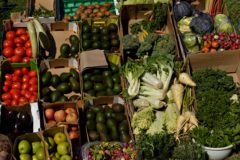Africa is heavily reliant on agriculture. Over the past decade, agriculture has constituted 42-48% of total employment on the continent. Subsistence farming is a mainstay of many African countries, especially south of the Sahara, which boasts a quarter of the world’s arable land and has an estimated 33 million smallholder farms, with agriculture contributing to 17% of gross domestic product (GDP).
Yet, the region produces only 10% of global output and imports most of the food it consumes. Around 82% of basic food imports still come from outside the continent. By 2021, food insecurity in Africa had risen alarmingly, affecting 794 million people—nearly 60% of its population.
Different factors contribute to this conundrum. Climate change has played a debilitating role, with attendant risks such as the loss of terrestrial, marine, and coastal ecosystems, thereby contributing to food insecurity.
The lack of large-scale industrialisation in the African agricultural sector is well-known, leading to far lower land productivity than the rest of the world. Another challenge is a wide investment gap. While several interventions have come from the African Development Bank (AfDB), the World Bank, and other multilateral institutions, government allocation to agriculture remains wanting. In 2021, the average government expenditure on agriculture in Africa was a meagre 4.1%. Private capital allocation—which is more efficient—also remains low. In the last decade, African agritech startups, per data from Agfunder, raised over $1.8 billion in funding.
However, the figure pales considerably when placed in perspective with worldwide funding figures. For comparison, African agritech startups in 2022 raised just a little over 2% of the $29.6 billion in total global funding within that sector.
Despite these challenges, there are opportunities for agritech to solve some of these agelong problems with the aid of artificial intelligence (AI) and allied technologies. In an earlier report this year, we noted that Africa’s AI market is projected to reach $6.9bn in 2024, with widespread application across various sectors. We will explore use cases showing how AI can be beneficial.
The case for precision agriculture
A 2020 study on Nigeria’s agricultural sector noted that:
- Ninety percent of agricultural production in Nigeria is the output of inefficient methods and deficient input use by small-scale farmers.
- Nigeria uses 18kg/hectare of inorganic fertiliser, compared to a global average of 100kg/hectare.
- Only 5% of Nigerian farmers use and access seeds of improved varieties compared to 25% in East Africa and 60% in Asia.
- Ten tractors exist for every 100 hectares, compared to Indonesia, which has 241 tractors per 100 hectares.
Another analysis by McKinsey determined that African agriculture had unrealized potential and could produce “two to three times more cereals and grains, which would add 20% more cereals and grains to global output.”
In light of these reasons, precision agriculture, which employs climate-smart solutions using advanced technology and sensor tools to aid crop management decisions and improve crop yield, has become vital. Other uses of AI in agriculture include pest and disease detection, harvesting and sorting, livestock management, and supply chain optimization.
India’s Agricultural Success Story Powered by AI
In 2020, the Indian centre of the World Economic Forum, in partnership with India’s Ministry of Agriculture and the state of Telangana, launched the AI4AI initiative (AI for Agriculture Innovation). Over eight months of workshops with smallholder farmers were organized, educating them on implementing new technologies, including AI, drones, and blockchain. The framework proposed incorporating smart farming and data-driven agriculture to achieve the end goals.
The pilot program was tested among 7,000 chilli farmers for 18 months over three crop cycles. Here are the key findings:
- An important component of this initiative was a WhatsApp chatbot developed in collaboration with an open-source developer. Designed in the local language of the farmers, the chatbot provided farmers with timely prompts in line with the maturity stages of their crops.
- An agritech startup built soil testing centres powered by machine learning technology that provided AI-based quality testing and a digital platform for buyer-seller connections.
- Farmers reported a significant increase in net income: $800 per acre in a single crop cycle (6 months), double the average income. They also significantly reduced wastage, which was as high as 40% before the start of the initiative.
- Digital advisory services contributed to a 21% increase in chilli yield production per acre.
- Pesticide use decreased by 9%, and fertilizers dropped by 5%.
- Quality improvements led to an 8% increase in unit prices.
- The initiative’s success led the state government to increase the number of crops to five and scale it to ten districts covering 500,000 farmers.
India’s success story, while commendable, is not isolated. In Senegal, there has been research into how combining algorithms with Internet of Things (IoT) detectors can develop sustainable automated irrigation systems. A World Bank study showed promising results from Ethiopia, Tanzania, and Uganda by highlighting how machine learning can help achieve transformational agriculture by optimizing clusters.
Local startups are also buying into these solutions. Nigerian-based agritech Kitovu employs an AI and data-driven agronomic advisory that uses remote sensing to provide insights for reducing input costs, increasing yield, and offering precise inputs and personalised soil and crop health analysis. East Africa-based Grekkon also specializes in AI-powered irrigation and greenhouses that serve tens of thousands of farmers.
Despite the stated benefits of AI, it still carries limitations. According to Adewale Adegoke, CEO of AgroXchange, an agricultural digital platform, the biggest challenge towards implementing precision agriculture remains data accessibility, especially for farmers who may find it tough to stay at pace with constantly emerging data.
There are also cultural impediments, like convincing farmers steeped in one way of farming to adopt new technologies. Much of the work requires mass education and a strong will to power through on the part of entrepreneurs who are invested in adopting AI at scale. It is, however, no longer a matter of blind faith—we now have ample evidence to show that AI can supercharge Africa towards the next phase of the agricultural revolution.


















